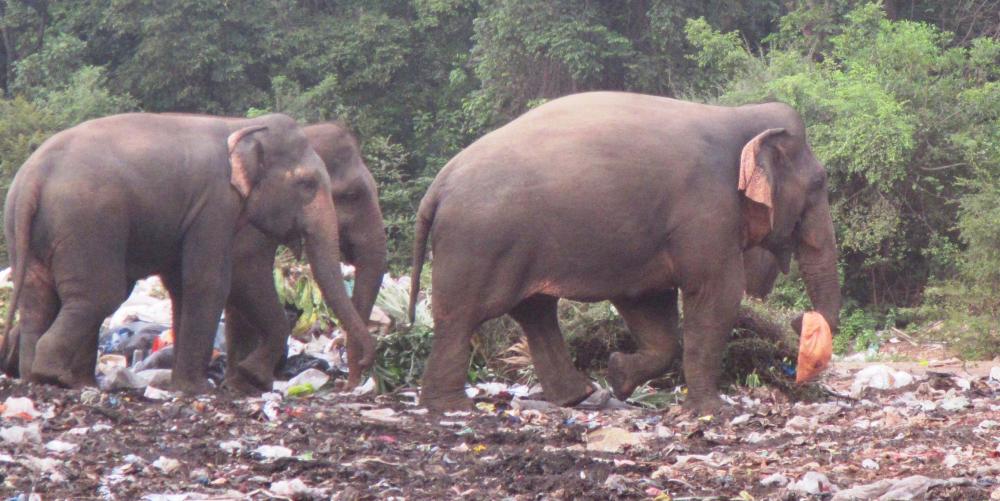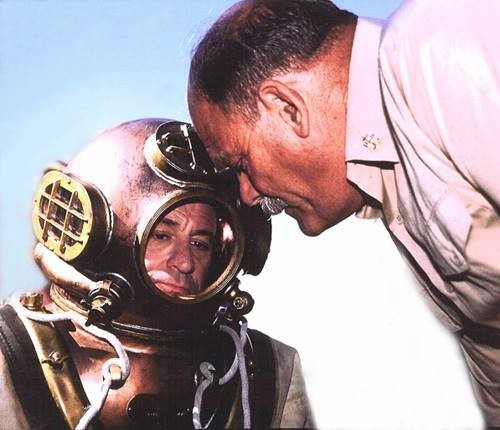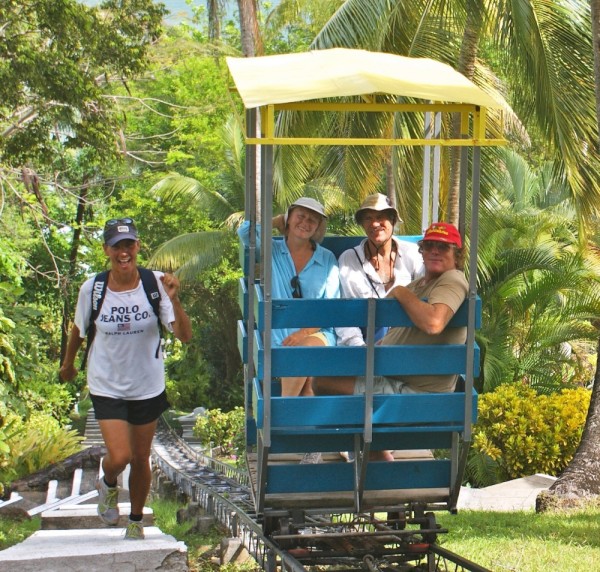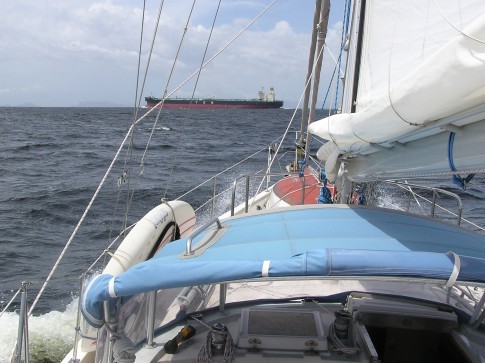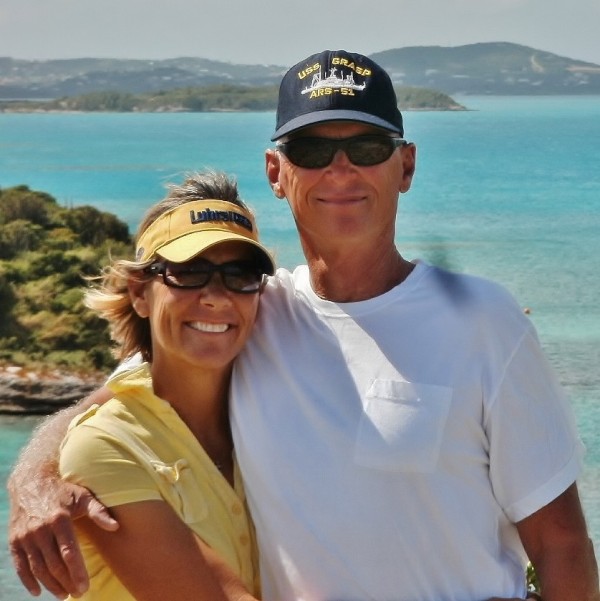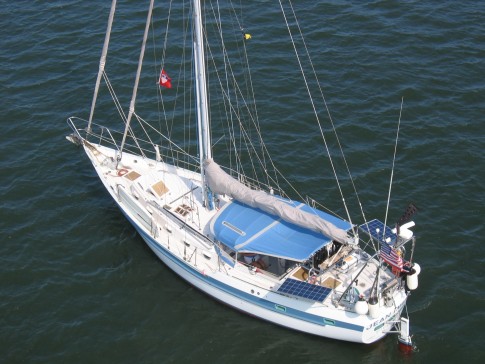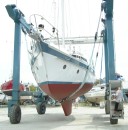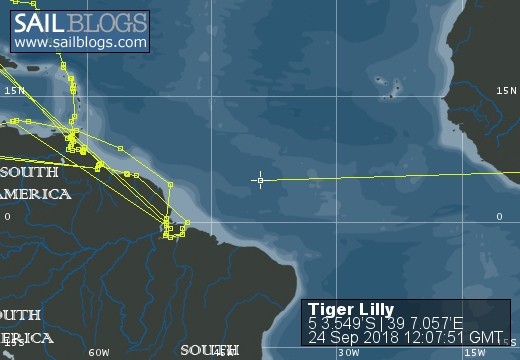
S/V Tiger Lilly
Rig heavy, reef early, and pray often; for God does not assure us an easy passage, but He does promise a safe anchorage...
25 May 2018 | TRINCOMALEE, SRI LANKA
02 January 2018 | Clan Jeti Anchorage, Georgetown, Penang Island, Malaysia
03 November 2016 | Singapore, Southeast Asia
02 October 2016 | Kumai River, Borneo
24 August 2016 | Rindja Island, Indonesia
22 July 2016 | Fannie Bay, Darwin, Northern Territory, Australia
14 June 2016 | Pancake Creek, Queensland, Australia
13 June 2016 | Pancake Creek, Queensland, Australia
11 June 2016 | Burnette Heads, Queensland, Australia
07 June 2016 | Mooloolaba, Queensland, Australia
11 May 2016 | Colmsie, Brisbane River, Queensland, Australia
23 December 2015 | Brisbane, Australia
13 August 2015 | Whangarei, New Zealand
07 August 2015 | Whangarei, New Zealand
23 July 2015 | Whangarei, New Zealand
12 April 2015 | Whangarei, New Zealand
11 February 2015 | Whangarei, New Zealand
25 January 2015 | Whangarei, New Zealand
24 September 2014 | BORA BORA, French Polynesia
23 September 2014 | Bora Bora
TIGER LILLY - SOUTH SEA VOYAGE
07 July 2014 | Iles Gambier, French Polynesia
Tom & Lilly
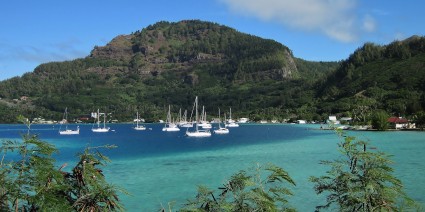
ARRIVAL ILES GAMBIER
At sunrise on Monday 23 June we arrived at the Iles Gambier in French Polynesia. Thirty-four days out of Las Perlas, Panama we safely anchored TIGER LILLY off the quiet village of Rikitea at Ile Mangareva. The name Mangareva translates "floating mountain" in the language spoken in the ancient Kingdom of Mangareva. Located in the temperate latitudes of the Southern Hemisphere, the Gambier Islands are high, green, wooded, and cool this time of year - quite beautiful and comfortable. Shortly after we anchored Lilly was off to the village with her new friend Cecilia from the French catamaran SV Contre Temps to take in the sights, meet the people, and to buy hot-fresh French baguettes. But the village baker would not sell her any - he GAVE them to her! What a nice way to say, "Welcome to my island!"
LIBERTY HOUND
In the Navy there is a name for those sailors who head for shore every chance they get - they are called Liberty Hounds.
Lilly sez: OH MY GOSH ladies! After 34 days at sea within 44 feet of Popeye the Sailor Man, then waiting through that last dark windy night hove-to outside of the reef under shortened sail anticipating the warmth of the coming sun, it was so nice to sail through the western pass of Iles Gambier at first light. Greeted by Isle Mangareva's high green Mount Mokoto backlit by the radiant glow of early morning, it seemed as though the very angels of heaven were waiting just beyond the peak - it was a magic experience. The island is covered by lush vegetation; dark mangrove forests and groves of sweeping coconut palms fringe the brilliant white sands of the shore, large trees climb the steep grade of the mountain, tenaciously clinging between rocky outcrops - their foliage swept back and up to the will of the wind. Wing-tip to wing-tip pairs of white long-tailed Tropic Birds aerobatically wheel over the face of the dark volcanic escarpment, diving and darting in and out of the emerald tree-tops and reveling in the joy of life. As we wound our way around the southern end of the island, the breeze swept the tropical fragrance of this Eden over TIGER LILLY and her expectant crew. You can imagine how excited we were as we rounded Point Teonekura and the quaint village of Rikitea came into view. Civilization! Bathed in the soft light of early morning, the waking Polynesian village was nestled between the brilliant greens of the rock-slashed mountain, and the sparkling hues of the lagoon as it transitioned from aquamarine, to azure, and finally a deep cobalt blue. The twin church steeples, colorful homes, and the secure harbor sheltering a hand-full of anchored sailing yachts was a most welcome sight to a couple of sailors just in from the sea. The real treasure of this island is her warm-hearted Mangarevan people and their happy children; an energetic wave from an open window as we walk past a tidy home, a friendly "Bon jure!" as we meet in the road, and their oh so wonderful habit of kissing cheeks as we stop to talk - they greet us everywhere we go. I love it here! Tom-Tom did a great job of getting us across four flippin thousand miles of the Pacific Ocean to this remote corner of Pacifica; after that long voyage I think of this place as Paradise Found - a treasure at the end of the rainbow. Polynesia is where I want to be; not at sea with the deck rolling, the wind blowing, and the salt spray flying. At this point in my cruising experience, the long sea passages are just to be endured - a time of reflection when I come to value remote destinations, new and exciting cultures, and anticipated friendships; a private place in the ocean where we earn the privilege to enjoy an island and her people - a precious memory to be treasured for life. At the end of that first day anchored off Isle Mangareva, it was so very nice to take a hot shower, crawl into a clean motionless bunk, and listen to the lovely Polynesian music coming from ashore. Color me happy.
OFF THE BEATEN PATH
There are about ten cruising sailboats anchored at Ile Mangareva, the largest island in the Gambier Group, with crews from several different countries - we are the only Americans. The Iles Gambier are comprised of Ile Mangareva, Ile Taravai, Ile Aukena, Ile Akamaru and several smaller islets. The 150 square mile lagoon is enclosed by a large horseshoe shaped reef system which is open to the south; navigation within the lagoon is challenging because of the presence of hundreds of buoyed aquaculture sites raising oysters for the black pearl industry. The Gambiers are not the usual destination for cruisers on the South Pacific Milk Run. The voyage down here from Panama was a boisterous beam-reach; not the more comfortable broad-reach usually experienced on the way to the popular Marquesas Islands in northern French Polynesia. Like most cruising destinations which are a bit more challenging to reach, the rewards are certainly worth the extra effort in getting here. The sense of inclusion with the local Polynesian community enjoyed by cruising sailors down here is truly delightful. On our second day on Isle Mangareva we went for a walk along the coast road that meanders between the steep green cliffs and the rocky shore. Along the way we were given arm-loads of fresh food by the local people. We returned to the boat with a stalk of bananas, a breadfruit, two pamplemousse (oh so sweet tropical grapefruit), half a dozen fish, two coconuts (shucked and shelled by the utility crew working along the road), and a hot baguette of French bread - it is the Polynesian way to treat visitors.
LIBERTE - EGALITE - FRATERNITE: Republique Francaise
Iles Gambier is a clean, prosperous place with their cultured pearl aqua culture businesses thriving. We continue to be impressed with the French colonial system, and the modern French colonial culture. In the past three years we have called at: the wind-swept islands of the French West Indies (Guadeloupe and Martinique); steamy French Guiana on the northeast coast of South America; and now here in Oceana at French Polynesia. At all of these French "colonies" we have seen first-hand that the native people who live in these Overseas Territories of France (actually French citizens living on French soil) are far better off for being French. Of course some of the local people would rather forgo the amenities and benefits of being associated with outsiders - the Magarevans are a proud people. However, done well, there are many mutual benefits to the colonization of developing countries by the First World. This is not necessarily a widely-held opinion by the Politically Correct of the First World who have not had an opportunity to actually live among the people or to compare and contrast their everyday living conditions. The French (and by association the European Community) spend a LOT of money on their colonies - far more than they get back. Schools, medical services, community infrastructure, employment, and security are all provided at First World levels. The standard of living and the quality of life is high in the French colonies - which make them very nice places to visit. These conditions are usually in stark contrast to neighboring self-governing island countries (often ex-English colonies) where poverty and corruption are the norm. During the last 27 years we have seen a refreshing and welcome change in the French sailors out cruising. The older generation of French sailors were usually quite insular; they seldom mixed with the rest of the cruising fleet - and of course they spoke ONLY French. The current generation of French cruising sailors are much more likely to participate in the international sailing scene with their fellow Citizens of the World; they struggle with English, while we hack our way through the beautiful French language, but somehow we communicate. We LIKE to visit the French Islands, and are enjoying the company of French cruisers!
SOUTH SEA PASSAGE
Our 34 day / 4100 mile voyage down the South Sea from Las Perlas islands of Panama to French Polynesia had the characteristics of the word "OHIO" - round on the ends, and high in the middle. The first 1000 miles out to the Galapagos Archipelago through the Inter Tropical Convergence Zone (the Doldrums) was slow - we averaged only 4 knots, or about 100 miles per day. The slowest day of our passage was on 26 May when we advanced only a dismal 31 miles in 24 hours - and part of that was motor-sailing to charge the batteries. As we sailed against adverse winds and currents off the northwest coast of South America we worked very hard for each and every mile. The 2700 miles of the middle passage (southwest across the Equator, and across the face of the Trade Winds in the tropical latitudes), was a fast and boisterous beam reach.
Lilly sez: I HATE it when he uses that "boisterous" word - I know that it really means ROUGH, WET, and YUCKY! Ever since we started cruising, Tom-Tom told me about the easy and enjoyable voyages we would have across the South Pacific. Well, the reality of our first, and longest, Pacific passage certainly was neither easy nor enjoyable.
Beam reaching is TIGER LILLY'S fastest point of sail, but with 20 to 25 knots of wind right on the side of the boat, along with the resultant 12 to 14 foot seas, it was a pretty rough and wet ride for 18 days as we averaged over 6 knots or 150 miles per day. All the ports and hatches were dogged-down, and three of the four companionway drop-boards were in place - it was a bit "close" below decks. About three times a day a large wave would SMACK TIGER LILLY just right, and WHAM-O everything and everybody got a major dose of high velocity salt water applied on the horizontal. On 6 June TIGER LILLY turned in her all-time career best NOON to NOON run of 191 miles - averaging 8 knots, all sailing, with no current helping!
Lilly sez: Miracle of miracles; can you believe it, with the boat all closed-up, pitching and bucking like a wild bronco - I never got sick! There were a few times when I took a couple of extra swallows - but the infamous Lilly Bucket never came out. Tom-Tom says that I am now a Sailorette - but I am not so sure.
As we closed in on our destination, the final 400 mile leg of our voyage found TIGER LILLY in the temperate latitudes and under a dome of high pressure - with very little wind. Our average daily run fell back to a paltry 90 miles, or only 3 3/4 knots. But one day at a time, we made it across one of the most remote areas of the world's largest ocean.
WHAT DO THEY DO ALL DAY?
The routine of sailing a boat on an extended passage under challenging weather conditions is actually a lot of work. Making a small boat on a big ocean sail where she doesn't want to go, feeding the crew for weeks at a time in rough conditions, fixing what absolutely has to be repaired to keep moving, and reduced sleep intervals due to watch standing 24-7 for over a month, really take a toll on those of us well past middle-age. This kind of sailing requires both physical and psychological stamina. The greatest hazards on passage are not usually the vicissitudes of the sea, but rather fatigue. Tired people can make bad decisions, and get into trouble - so we carefully stay tuned to each other's energy levels. It is how we stay safe.
Lilly sez: You should see my Tom-Tom the Sailorman work to keep TIGER LILLY sailing to her best advantage. During the extremes of light wind or heavy weather he seems to move continuously. The deck lights come on to check the sails, then he's back and forth in the cockpit trimming jib sheets. The wind is up - then it is down - and he is at the mast tucking in or shaking out reefs in the main sail; and the winch pawls are clicking away in the spinning winches. The wind veers and he is on the aft deck to tweek the wind vane self-steering gear, and then back to the cockpit for more sheet trimming. Ashore his detail-oriented Navy Man mentality can be a bit frustrating - Ladies, you can read between the lines on that one - but on the ocean, I feel completely safe with this man.
Right after sunrise we usually make a tour topside and return to the sea the bodies of flying fish which have flown aboard and crash-landed during the night, along with those squid which have been washed up on deck by the waves. The two major events of our typical day on passage were our afternoon main meal, and contact with the outside world on the Pacific Seafarers Ham Radio Net each evening.
FEEDING THE TIGERS
Lilly worked hard to put a tasty and nutritious main meal on the dinette table each and every day - no matter what the weather, or how she felt. That certainly was not easy with all the banging around we did, but somehow it all came together - six weeks away from the last grocery store, and under some very challenging conditions.
Lilly sez: Ladies, picture working at your kitchen counter tilted over at about 15 degrees; then rolling another 30 degrees both ways every 15 seconds or so - but never the same way twice in a row. I NEVER leave ANYTHING on the countertop unattended or unsecured, or it is very likely to go flying. Often, a horrendous noise would assault my ears, and I would hang-on and brace myself against a bone-jarring shaking from the rigging and sails as the boat fell off the top of waves higher than our house back in Suburbia! Two hands are just not enough for a sea cook working in these conditions, and I was very careful anytime I was using a knife. I am so grateful that I did not get seasick - thank goodness I was able to do my share of the work and watch-keeping. Let me leave it to your imagination to visualize the in-delicate contortions necessary to brace one-self securely while using the head under these challenging conditions.
TAP TAP TAP - Is this thing working?
Although we had planned on remote-filing daily updates to this blog via the HAM Radio WINLINK email system while we were on passage, the weather was just too nasty to get the laptop out each day and risk getting it wet or smashed. Thankfully, there was a much easier alternative, the Pacific Seafarers HAM voice radio net. At 0300 ZULU (Greenwich Mean Time) each evening we tuned the HF Single Side Band radio to 14.300 MHZ, bounced our signal off the F layers of the ionosphere, and checked-in with the Pacific Seafarers Net. The Net control was usually a station in Hawaii or California - and we regularly had contact with Fred (W3ZU), a net relay station 4500 miles away in central Florida. We reported our position, course and speed, and current weather conditions. Additionally, this HAM Radio net provides a central meeting point for vessels which desire to contact each other while at sea. What a great service these dedicated and skilled shore-based Amateur Radio operators provide to the HAM Radio Maritime Mobile cruising community and their families. Many of the folks who operate the net are ex-sailors who have swallowed the anchor. The roll call information is posted each day on their website (www.pacsea.net), so that friends and family can monitor our progress. While we are at sea we know that the Net is ready, willing, and able to provide any communication assistance (and moral support) we might need should trouble arise and we need to make contact ashore. Here are some of the situations we heard reported on the Pacific Seafarers Net by other boats during our passage: One boat had a broken head stay fitting at the top of the mast (thankfully, the rig did not come down and they safely returned to Hawaii). Another boat just a few days out of Hawaii broke their steering cable - with no spare onboard (they returned to Honolulu using their electric autopilot). Saltwater contaminated a boat's diesel fuel tank (they had to abort their passage to French Polynesia and return to Panama). Pitcairn Island Longboats MOSS and O'LEARY motored 300 miles to Iles Gambier to transport a man with a severely infected leg to the French air ambulance (the MEDEVAC was completed, and the patient was flown on to Tahiti for treatment). We met the Pitcairn sailors while they were at Rikitea, and stood by as a radio relay for them on their return voyage. We heard a heart-breaking report that a cruising-couple was stranded on a reef in the Tuamotu Archipelago - and they were watching their boat break up in heavy surf. These incidents, reported from around the Pacific cruising fleet, tended to focus us on the business at hand - ocean sailing is not a drill. More than once we thought, "There but for the grace of God." Several times Lilly called her son Ryan in New Mexico on a phone-patch through Fred (W3ZU) in Inverness, Florida. Fred is a retired professional radio broadcast engineer and Merchant Marine Radio Officer; and he has one of the strongest and clearest HAM radio signals on the airways. On their last phone patch Ryan told his Mom that he had just won the 2014 New Mexico Category Pro One-Two Criterium Cycling State Championship. CONGRATULATIONS RYAN SZABO! You can imagine how proud and happy that news made Lilly feel. We send out a heartfelt BRAVO ZULU to Fred (W3ZU) and all the HAM Radio operators who make life far from our loved ones just a little bit better - and safer.
PASSAGE HIGHLIGHTS (and lowlights)
There were some special moments along the way to break up the routine of thousands of miles of ocean sailing:
Day 12 - Isla Pinta, a sail-by in the Galapagos Archipelago
As we passed through the Galapagos Islands we diverted our course and came in close under the eastern shore of uninhabited Isla Pinta. After 12 days at sea we were fascinated by the sight of so much vigorous sea life juxtaposed against the stark other-worldly landscape. Huge sea lions sun bathed and preened themselves on the dark rocks just above the crashing surf, hundreds of noisy sea birds soared and wheeled above our mast head against an azure sky, and playful dolphins charged and jumped in TIGER LILLY'S sparkling bow wave. As we sailed along the dark and desolate lava fields that pushed right down to the sea from two high active volcanoes with their peaks in the clouds, it looked like an eerie scene one of NASA's Landers might have encountered on the surface of Mars. Unfortunately, the Customs, Immigration, and Cruising Permit fees in the Galapagos are exorbitant (and way beyond our budget); the cost certainly does not represent any sort of value considering the stringent cruising limits imposed on visiting yachts - so we gave the Galapagos a pass, and sailed on to French Polynesia.
Day 19 - Over The Hump Day
When we passed the mid-point in our 4100 mile voyage we had intended to celebrate with the traditional special meal. Unfortunately, the weather was just too sloppy to do anything other than squat down in the leeward corner of the cockpit and hang on by our toenails while churning the ubiquitous chicken and rice stew out of a bowl like a Chinaman. Two days later the weather cleared a bit and Lilly served up a delicious feast of baked salmon, mashed potatoes, fresh (frozen) vegetables, and topped-off with home-made ice cream Sundays for dessert. YUM, YUM; and BRAVO ZULU to the Chef!
Day 21 - The Great Chili Spill
In sloppy weather, it is convenient to make a large pot of food, and eat from it for multiple meals. It seems that Herself had a huge pot of chili cooking on top of the stove when the boat took a deep roll to port. The gimbaled stove swung down maintaining a level cooking surface; but as a result of the momentum of the roll, the unrestrained chili pot slid outboard and under the cabinet bottom behind the stove - pinning the pot between the stove top and the cabinet bottom. The boat then took a not-unexpected snap-roll back to starboard. LILLY-CHILI WENT EVERYWHERE! Fortunately, Lilly was not burned while she was trying desperately to free the jammed pot. Tom, sleeping in the aft cabin, woke-up to a shriek not-unlike that of an enraged eagle. Lilly was covered in chili from head to toe (with plenty between her toes too), as was the stove, the deck, and most of the galley. It looked a lot like the seagoing chili version of Lucille Ball's skit - Lucy at the chocolate factory! While dabbing her person down with a damp rag, the Captain held extra instruction on the spot regarding safe cooking operations, and the use of stove-top pot-restraining devices (buried in a locker). At that point, Lilly was madder than a wet hen, and did not seem to appreciate the wisdom of her more experienced skipper. The really difficult to understand aspect of this unpleasant accident (and incidentally other weather-related incidents) is that somehow she seems to hold Tom personally responsible for the sea conditions! Live and learn Boot Camp!
Lilly sez: I'll give him a pot-restraining device - and once embedded, he will be able to use the flippin thing for a hat-restraining device! Well, I am here to tell you that Mr. Smoothie got himself an extra dose of red pepper in his chili that night - and I am happy to report that it had the desired effect the next day!
Day 28 - Thar She Blows!
One evening just before sunset, as we were about 500 miles northeast of Iles Gambier; Lilly was on watch in the cockpit and thought that she could hear sounds like voices - then she definitely heard a pronounced "WHOOSH" close aboard. Spaceship TIGER LILLY was surrounded by a large pod of huge whales - perhaps twenty - they were difficult to count! We both headed for the aft deck to get a better view; we hung on to the utility arch to steady ourselves on the rolling deck as we watched them in awe. There was nothing else we could do - we were totally at their mercy. We were making good about 6 knots towards the southwest at the time, and they swam down both sides of the boat as they easily passed us. Some of them were quite close - perhaps within a boat length or so. What a MAJESTIC SIGHT; it was so very humbling to be in their presence. They were with us for about 45 minutes, and then just as suddenly as they appeared, they were off to the western horizon. It is a sea story we shall never forget; the power they displayed as they maneuvered through the large breaking waves, their obvious intelligence and curiosity, and the grace of their movements - it was an overwhelming experience. Afterwards we got out our handy-dandy whale identification guide, which we keep in the chart table just for such an occasion, and through a process of elimination determined that they were likely Fin whales. We had thought that we were quite alone in a very remote corner of the Blue Planet, yet here was this community of gentle giants reminding us that we are never alone. All of God's creatures, great and small, are truly magnificent.
COMING ATTRACTIONS
We are looking forward to the next three weeks or so in the Iles Gambier. Down here in the temperate latitudes of the Southern Hemisphere it is winter, and we have broken out our long-sleeved shirts and light jackets - but it certainly is great sleeping weather. Tom-Tom is trying to talk Swim Champ into getting in the water and cleaning the propeller and fathometer transducer - but she is having none of that. The cool (70 degree) water is just not her cup of tea! Each evening the village residents practice traditional Polynesian music and dances in preparation for their French Independence celebration - which should be quite a treat. The three-week long July fete includes traditional music and dancing, soccer and volleyball tournaments, canoe races, native crafts, a parade, and feasting. It is the real deal - and done just for the Islander's own enjoyment. On the opening day of the celebrations, the townspeople told the yachties to be at the town wharf at 1400. We expectantly gathered under the pavilion wondering what they had in store for us - just 100 years ago the Mangarevians were headhunters! Then we heard the sound of drums and singing coming down the road and several trucks pulled into the wharf area, loaded with dancers and drummers who had come to invite us to the fete. First, they performed their traditional dances for us, accompanied by fantastic drumming, and then they invited us to their celebration with baskets of fresh fruit for each boat - what a wonderful Polynesian welcome! With very few tourists in this remote corner of Polynesia, the visiting yachties are graciously included in their festivities. The hills of Ile Mangareva are green and verdant, with plenty of hiking trails, so while we are here we will take the opportunity to get in some much needed exercise. And of course there is the ever-present (and ever growing) To-Do List. As we look out across the clear lagoon of Iles Gambier to the fringing reef, it is hard to believe that last year at this time we were exploring the tropical jungles and fast running rivers of Amazonia. In the last 14 months we have sailed some 10,000 miles and visited 8 different countries and island groups. Those sea miles, and the enjoyable time ashore spent touring and exploring (read that not working on the boat) have taken their toll on the boat's systems and gear. Thankfully, she is a Good Old Boat - sound and strong in her hull, deck, and rig. Spaceship TIGER LILLY has taken very good care of us in some difficult conditions, and we certainly do not begrudge her our attentions. Some wag once remarked that cruising under sail is nothing more than doing boat work in exotic locations - and we might add, without logistic support. We intend to do more than just work on the boat while we are here in Paradise Found; hopefully, the big jobs can wait another 4 months until New Zealand and cyclone season - some 4000 more miles to the west. Oh Lord, your ocean is so big, and our boat is so small!
We have posted some pictures from the Iles Gambier in our French Polynesia photo album. If you would like to view them, go to the upper right corner of this page, click on PHOTO GALLERY, and navigate thusly: Ports of Call / By Sea / Oceana / French Polynesia / Gambier. See you there!
At sunrise on Monday 23 June we arrived at the Iles Gambier in French Polynesia. Thirty-four days out of Las Perlas, Panama we safely anchored TIGER LILLY off the quiet village of Rikitea at Ile Mangareva. The name Mangareva translates "floating mountain" in the language spoken in the ancient Kingdom of Mangareva. Located in the temperate latitudes of the Southern Hemisphere, the Gambier Islands are high, green, wooded, and cool this time of year - quite beautiful and comfortable. Shortly after we anchored Lilly was off to the village with her new friend Cecilia from the French catamaran SV Contre Temps to take in the sights, meet the people, and to buy hot-fresh French baguettes. But the village baker would not sell her any - he GAVE them to her! What a nice way to say, "Welcome to my island!"
LIBERTY HOUND
In the Navy there is a name for those sailors who head for shore every chance they get - they are called Liberty Hounds.
Lilly sez: OH MY GOSH ladies! After 34 days at sea within 44 feet of Popeye the Sailor Man, then waiting through that last dark windy night hove-to outside of the reef under shortened sail anticipating the warmth of the coming sun, it was so nice to sail through the western pass of Iles Gambier at first light. Greeted by Isle Mangareva's high green Mount Mokoto backlit by the radiant glow of early morning, it seemed as though the very angels of heaven were waiting just beyond the peak - it was a magic experience. The island is covered by lush vegetation; dark mangrove forests and groves of sweeping coconut palms fringe the brilliant white sands of the shore, large trees climb the steep grade of the mountain, tenaciously clinging between rocky outcrops - their foliage swept back and up to the will of the wind. Wing-tip to wing-tip pairs of white long-tailed Tropic Birds aerobatically wheel over the face of the dark volcanic escarpment, diving and darting in and out of the emerald tree-tops and reveling in the joy of life. As we wound our way around the southern end of the island, the breeze swept the tropical fragrance of this Eden over TIGER LILLY and her expectant crew. You can imagine how excited we were as we rounded Point Teonekura and the quaint village of Rikitea came into view. Civilization! Bathed in the soft light of early morning, the waking Polynesian village was nestled between the brilliant greens of the rock-slashed mountain, and the sparkling hues of the lagoon as it transitioned from aquamarine, to azure, and finally a deep cobalt blue. The twin church steeples, colorful homes, and the secure harbor sheltering a hand-full of anchored sailing yachts was a most welcome sight to a couple of sailors just in from the sea. The real treasure of this island is her warm-hearted Mangarevan people and their happy children; an energetic wave from an open window as we walk past a tidy home, a friendly "Bon jure!" as we meet in the road, and their oh so wonderful habit of kissing cheeks as we stop to talk - they greet us everywhere we go. I love it here! Tom-Tom did a great job of getting us across four flippin thousand miles of the Pacific Ocean to this remote corner of Pacifica; after that long voyage I think of this place as Paradise Found - a treasure at the end of the rainbow. Polynesia is where I want to be; not at sea with the deck rolling, the wind blowing, and the salt spray flying. At this point in my cruising experience, the long sea passages are just to be endured - a time of reflection when I come to value remote destinations, new and exciting cultures, and anticipated friendships; a private place in the ocean where we earn the privilege to enjoy an island and her people - a precious memory to be treasured for life. At the end of that first day anchored off Isle Mangareva, it was so very nice to take a hot shower, crawl into a clean motionless bunk, and listen to the lovely Polynesian music coming from ashore. Color me happy.
OFF THE BEATEN PATH
There are about ten cruising sailboats anchored at Ile Mangareva, the largest island in the Gambier Group, with crews from several different countries - we are the only Americans. The Iles Gambier are comprised of Ile Mangareva, Ile Taravai, Ile Aukena, Ile Akamaru and several smaller islets. The 150 square mile lagoon is enclosed by a large horseshoe shaped reef system which is open to the south; navigation within the lagoon is challenging because of the presence of hundreds of buoyed aquaculture sites raising oysters for the black pearl industry. The Gambiers are not the usual destination for cruisers on the South Pacific Milk Run. The voyage down here from Panama was a boisterous beam-reach; not the more comfortable broad-reach usually experienced on the way to the popular Marquesas Islands in northern French Polynesia. Like most cruising destinations which are a bit more challenging to reach, the rewards are certainly worth the extra effort in getting here. The sense of inclusion with the local Polynesian community enjoyed by cruising sailors down here is truly delightful. On our second day on Isle Mangareva we went for a walk along the coast road that meanders between the steep green cliffs and the rocky shore. Along the way we were given arm-loads of fresh food by the local people. We returned to the boat with a stalk of bananas, a breadfruit, two pamplemousse (oh so sweet tropical grapefruit), half a dozen fish, two coconuts (shucked and shelled by the utility crew working along the road), and a hot baguette of French bread - it is the Polynesian way to treat visitors.
LIBERTE - EGALITE - FRATERNITE: Republique Francaise
Iles Gambier is a clean, prosperous place with their cultured pearl aqua culture businesses thriving. We continue to be impressed with the French colonial system, and the modern French colonial culture. In the past three years we have called at: the wind-swept islands of the French West Indies (Guadeloupe and Martinique); steamy French Guiana on the northeast coast of South America; and now here in Oceana at French Polynesia. At all of these French "colonies" we have seen first-hand that the native people who live in these Overseas Territories of France (actually French citizens living on French soil) are far better off for being French. Of course some of the local people would rather forgo the amenities and benefits of being associated with outsiders - the Magarevans are a proud people. However, done well, there are many mutual benefits to the colonization of developing countries by the First World. This is not necessarily a widely-held opinion by the Politically Correct of the First World who have not had an opportunity to actually live among the people or to compare and contrast their everyday living conditions. The French (and by association the European Community) spend a LOT of money on their colonies - far more than they get back. Schools, medical services, community infrastructure, employment, and security are all provided at First World levels. The standard of living and the quality of life is high in the French colonies - which make them very nice places to visit. These conditions are usually in stark contrast to neighboring self-governing island countries (often ex-English colonies) where poverty and corruption are the norm. During the last 27 years we have seen a refreshing and welcome change in the French sailors out cruising. The older generation of French sailors were usually quite insular; they seldom mixed with the rest of the cruising fleet - and of course they spoke ONLY French. The current generation of French cruising sailors are much more likely to participate in the international sailing scene with their fellow Citizens of the World; they struggle with English, while we hack our way through the beautiful French language, but somehow we communicate. We LIKE to visit the French Islands, and are enjoying the company of French cruisers!
SOUTH SEA PASSAGE
Our 34 day / 4100 mile voyage down the South Sea from Las Perlas islands of Panama to French Polynesia had the characteristics of the word "OHIO" - round on the ends, and high in the middle. The first 1000 miles out to the Galapagos Archipelago through the Inter Tropical Convergence Zone (the Doldrums) was slow - we averaged only 4 knots, or about 100 miles per day. The slowest day of our passage was on 26 May when we advanced only a dismal 31 miles in 24 hours - and part of that was motor-sailing to charge the batteries. As we sailed against adverse winds and currents off the northwest coast of South America we worked very hard for each and every mile. The 2700 miles of the middle passage (southwest across the Equator, and across the face of the Trade Winds in the tropical latitudes), was a fast and boisterous beam reach.
Lilly sez: I HATE it when he uses that "boisterous" word - I know that it really means ROUGH, WET, and YUCKY! Ever since we started cruising, Tom-Tom told me about the easy and enjoyable voyages we would have across the South Pacific. Well, the reality of our first, and longest, Pacific passage certainly was neither easy nor enjoyable.
Beam reaching is TIGER LILLY'S fastest point of sail, but with 20 to 25 knots of wind right on the side of the boat, along with the resultant 12 to 14 foot seas, it was a pretty rough and wet ride for 18 days as we averaged over 6 knots or 150 miles per day. All the ports and hatches were dogged-down, and three of the four companionway drop-boards were in place - it was a bit "close" below decks. About three times a day a large wave would SMACK TIGER LILLY just right, and WHAM-O everything and everybody got a major dose of high velocity salt water applied on the horizontal. On 6 June TIGER LILLY turned in her all-time career best NOON to NOON run of 191 miles - averaging 8 knots, all sailing, with no current helping!
Lilly sez: Miracle of miracles; can you believe it, with the boat all closed-up, pitching and bucking like a wild bronco - I never got sick! There were a few times when I took a couple of extra swallows - but the infamous Lilly Bucket never came out. Tom-Tom says that I am now a Sailorette - but I am not so sure.
As we closed in on our destination, the final 400 mile leg of our voyage found TIGER LILLY in the temperate latitudes and under a dome of high pressure - with very little wind. Our average daily run fell back to a paltry 90 miles, or only 3 3/4 knots. But one day at a time, we made it across one of the most remote areas of the world's largest ocean.
WHAT DO THEY DO ALL DAY?
The routine of sailing a boat on an extended passage under challenging weather conditions is actually a lot of work. Making a small boat on a big ocean sail where she doesn't want to go, feeding the crew for weeks at a time in rough conditions, fixing what absolutely has to be repaired to keep moving, and reduced sleep intervals due to watch standing 24-7 for over a month, really take a toll on those of us well past middle-age. This kind of sailing requires both physical and psychological stamina. The greatest hazards on passage are not usually the vicissitudes of the sea, but rather fatigue. Tired people can make bad decisions, and get into trouble - so we carefully stay tuned to each other's energy levels. It is how we stay safe.
Lilly sez: You should see my Tom-Tom the Sailorman work to keep TIGER LILLY sailing to her best advantage. During the extremes of light wind or heavy weather he seems to move continuously. The deck lights come on to check the sails, then he's back and forth in the cockpit trimming jib sheets. The wind is up - then it is down - and he is at the mast tucking in or shaking out reefs in the main sail; and the winch pawls are clicking away in the spinning winches. The wind veers and he is on the aft deck to tweek the wind vane self-steering gear, and then back to the cockpit for more sheet trimming. Ashore his detail-oriented Navy Man mentality can be a bit frustrating - Ladies, you can read between the lines on that one - but on the ocean, I feel completely safe with this man.
Right after sunrise we usually make a tour topside and return to the sea the bodies of flying fish which have flown aboard and crash-landed during the night, along with those squid which have been washed up on deck by the waves. The two major events of our typical day on passage were our afternoon main meal, and contact with the outside world on the Pacific Seafarers Ham Radio Net each evening.
FEEDING THE TIGERS
Lilly worked hard to put a tasty and nutritious main meal on the dinette table each and every day - no matter what the weather, or how she felt. That certainly was not easy with all the banging around we did, but somehow it all came together - six weeks away from the last grocery store, and under some very challenging conditions.
Lilly sez: Ladies, picture working at your kitchen counter tilted over at about 15 degrees; then rolling another 30 degrees both ways every 15 seconds or so - but never the same way twice in a row. I NEVER leave ANYTHING on the countertop unattended or unsecured, or it is very likely to go flying. Often, a horrendous noise would assault my ears, and I would hang-on and brace myself against a bone-jarring shaking from the rigging and sails as the boat fell off the top of waves higher than our house back in Suburbia! Two hands are just not enough for a sea cook working in these conditions, and I was very careful anytime I was using a knife. I am so grateful that I did not get seasick - thank goodness I was able to do my share of the work and watch-keeping. Let me leave it to your imagination to visualize the in-delicate contortions necessary to brace one-self securely while using the head under these challenging conditions.
TAP TAP TAP - Is this thing working?
Although we had planned on remote-filing daily updates to this blog via the HAM Radio WINLINK email system while we were on passage, the weather was just too nasty to get the laptop out each day and risk getting it wet or smashed. Thankfully, there was a much easier alternative, the Pacific Seafarers HAM voice radio net. At 0300 ZULU (Greenwich Mean Time) each evening we tuned the HF Single Side Band radio to 14.300 MHZ, bounced our signal off the F layers of the ionosphere, and checked-in with the Pacific Seafarers Net. The Net control was usually a station in Hawaii or California - and we regularly had contact with Fred (W3ZU), a net relay station 4500 miles away in central Florida. We reported our position, course and speed, and current weather conditions. Additionally, this HAM Radio net provides a central meeting point for vessels which desire to contact each other while at sea. What a great service these dedicated and skilled shore-based Amateur Radio operators provide to the HAM Radio Maritime Mobile cruising community and their families. Many of the folks who operate the net are ex-sailors who have swallowed the anchor. The roll call information is posted each day on their website (www.pacsea.net), so that friends and family can monitor our progress. While we are at sea we know that the Net is ready, willing, and able to provide any communication assistance (and moral support) we might need should trouble arise and we need to make contact ashore. Here are some of the situations we heard reported on the Pacific Seafarers Net by other boats during our passage: One boat had a broken head stay fitting at the top of the mast (thankfully, the rig did not come down and they safely returned to Hawaii). Another boat just a few days out of Hawaii broke their steering cable - with no spare onboard (they returned to Honolulu using their electric autopilot). Saltwater contaminated a boat's diesel fuel tank (they had to abort their passage to French Polynesia and return to Panama). Pitcairn Island Longboats MOSS and O'LEARY motored 300 miles to Iles Gambier to transport a man with a severely infected leg to the French air ambulance (the MEDEVAC was completed, and the patient was flown on to Tahiti for treatment). We met the Pitcairn sailors while they were at Rikitea, and stood by as a radio relay for them on their return voyage. We heard a heart-breaking report that a cruising-couple was stranded on a reef in the Tuamotu Archipelago - and they were watching their boat break up in heavy surf. These incidents, reported from around the Pacific cruising fleet, tended to focus us on the business at hand - ocean sailing is not a drill. More than once we thought, "There but for the grace of God." Several times Lilly called her son Ryan in New Mexico on a phone-patch through Fred (W3ZU) in Inverness, Florida. Fred is a retired professional radio broadcast engineer and Merchant Marine Radio Officer; and he has one of the strongest and clearest HAM radio signals on the airways. On their last phone patch Ryan told his Mom that he had just won the 2014 New Mexico Category Pro One-Two Criterium Cycling State Championship. CONGRATULATIONS RYAN SZABO! You can imagine how proud and happy that news made Lilly feel. We send out a heartfelt BRAVO ZULU to Fred (W3ZU) and all the HAM Radio operators who make life far from our loved ones just a little bit better - and safer.
PASSAGE HIGHLIGHTS (and lowlights)
There were some special moments along the way to break up the routine of thousands of miles of ocean sailing:
Day 12 - Isla Pinta, a sail-by in the Galapagos Archipelago
As we passed through the Galapagos Islands we diverted our course and came in close under the eastern shore of uninhabited Isla Pinta. After 12 days at sea we were fascinated by the sight of so much vigorous sea life juxtaposed against the stark other-worldly landscape. Huge sea lions sun bathed and preened themselves on the dark rocks just above the crashing surf, hundreds of noisy sea birds soared and wheeled above our mast head against an azure sky, and playful dolphins charged and jumped in TIGER LILLY'S sparkling bow wave. As we sailed along the dark and desolate lava fields that pushed right down to the sea from two high active volcanoes with their peaks in the clouds, it looked like an eerie scene one of NASA's Landers might have encountered on the surface of Mars. Unfortunately, the Customs, Immigration, and Cruising Permit fees in the Galapagos are exorbitant (and way beyond our budget); the cost certainly does not represent any sort of value considering the stringent cruising limits imposed on visiting yachts - so we gave the Galapagos a pass, and sailed on to French Polynesia.
Day 19 - Over The Hump Day
When we passed the mid-point in our 4100 mile voyage we had intended to celebrate with the traditional special meal. Unfortunately, the weather was just too sloppy to do anything other than squat down in the leeward corner of the cockpit and hang on by our toenails while churning the ubiquitous chicken and rice stew out of a bowl like a Chinaman. Two days later the weather cleared a bit and Lilly served up a delicious feast of baked salmon, mashed potatoes, fresh (frozen) vegetables, and topped-off with home-made ice cream Sundays for dessert. YUM, YUM; and BRAVO ZULU to the Chef!
Day 21 - The Great Chili Spill
In sloppy weather, it is convenient to make a large pot of food, and eat from it for multiple meals. It seems that Herself had a huge pot of chili cooking on top of the stove when the boat took a deep roll to port. The gimbaled stove swung down maintaining a level cooking surface; but as a result of the momentum of the roll, the unrestrained chili pot slid outboard and under the cabinet bottom behind the stove - pinning the pot between the stove top and the cabinet bottom. The boat then took a not-unexpected snap-roll back to starboard. LILLY-CHILI WENT EVERYWHERE! Fortunately, Lilly was not burned while she was trying desperately to free the jammed pot. Tom, sleeping in the aft cabin, woke-up to a shriek not-unlike that of an enraged eagle. Lilly was covered in chili from head to toe (with plenty between her toes too), as was the stove, the deck, and most of the galley. It looked a lot like the seagoing chili version of Lucille Ball's skit - Lucy at the chocolate factory! While dabbing her person down with a damp rag, the Captain held extra instruction on the spot regarding safe cooking operations, and the use of stove-top pot-restraining devices (buried in a locker). At that point, Lilly was madder than a wet hen, and did not seem to appreciate the wisdom of her more experienced skipper. The really difficult to understand aspect of this unpleasant accident (and incidentally other weather-related incidents) is that somehow she seems to hold Tom personally responsible for the sea conditions! Live and learn Boot Camp!
Lilly sez: I'll give him a pot-restraining device - and once embedded, he will be able to use the flippin thing for a hat-restraining device! Well, I am here to tell you that Mr. Smoothie got himself an extra dose of red pepper in his chili that night - and I am happy to report that it had the desired effect the next day!
Day 28 - Thar She Blows!
One evening just before sunset, as we were about 500 miles northeast of Iles Gambier; Lilly was on watch in the cockpit and thought that she could hear sounds like voices - then she definitely heard a pronounced "WHOOSH" close aboard. Spaceship TIGER LILLY was surrounded by a large pod of huge whales - perhaps twenty - they were difficult to count! We both headed for the aft deck to get a better view; we hung on to the utility arch to steady ourselves on the rolling deck as we watched them in awe. There was nothing else we could do - we were totally at their mercy. We were making good about 6 knots towards the southwest at the time, and they swam down both sides of the boat as they easily passed us. Some of them were quite close - perhaps within a boat length or so. What a MAJESTIC SIGHT; it was so very humbling to be in their presence. They were with us for about 45 minutes, and then just as suddenly as they appeared, they were off to the western horizon. It is a sea story we shall never forget; the power they displayed as they maneuvered through the large breaking waves, their obvious intelligence and curiosity, and the grace of their movements - it was an overwhelming experience. Afterwards we got out our handy-dandy whale identification guide, which we keep in the chart table just for such an occasion, and through a process of elimination determined that they were likely Fin whales. We had thought that we were quite alone in a very remote corner of the Blue Planet, yet here was this community of gentle giants reminding us that we are never alone. All of God's creatures, great and small, are truly magnificent.
COMING ATTRACTIONS
We are looking forward to the next three weeks or so in the Iles Gambier. Down here in the temperate latitudes of the Southern Hemisphere it is winter, and we have broken out our long-sleeved shirts and light jackets - but it certainly is great sleeping weather. Tom-Tom is trying to talk Swim Champ into getting in the water and cleaning the propeller and fathometer transducer - but she is having none of that. The cool (70 degree) water is just not her cup of tea! Each evening the village residents practice traditional Polynesian music and dances in preparation for their French Independence celebration - which should be quite a treat. The three-week long July fete includes traditional music and dancing, soccer and volleyball tournaments, canoe races, native crafts, a parade, and feasting. It is the real deal - and done just for the Islander's own enjoyment. On the opening day of the celebrations, the townspeople told the yachties to be at the town wharf at 1400. We expectantly gathered under the pavilion wondering what they had in store for us - just 100 years ago the Mangarevians were headhunters! Then we heard the sound of drums and singing coming down the road and several trucks pulled into the wharf area, loaded with dancers and drummers who had come to invite us to the fete. First, they performed their traditional dances for us, accompanied by fantastic drumming, and then they invited us to their celebration with baskets of fresh fruit for each boat - what a wonderful Polynesian welcome! With very few tourists in this remote corner of Polynesia, the visiting yachties are graciously included in their festivities. The hills of Ile Mangareva are green and verdant, with plenty of hiking trails, so while we are here we will take the opportunity to get in some much needed exercise. And of course there is the ever-present (and ever growing) To-Do List. As we look out across the clear lagoon of Iles Gambier to the fringing reef, it is hard to believe that last year at this time we were exploring the tropical jungles and fast running rivers of Amazonia. In the last 14 months we have sailed some 10,000 miles and visited 8 different countries and island groups. Those sea miles, and the enjoyable time ashore spent touring and exploring (read that not working on the boat) have taken their toll on the boat's systems and gear. Thankfully, she is a Good Old Boat - sound and strong in her hull, deck, and rig. Spaceship TIGER LILLY has taken very good care of us in some difficult conditions, and we certainly do not begrudge her our attentions. Some wag once remarked that cruising under sail is nothing more than doing boat work in exotic locations - and we might add, without logistic support. We intend to do more than just work on the boat while we are here in Paradise Found; hopefully, the big jobs can wait another 4 months until New Zealand and cyclone season - some 4000 more miles to the west. Oh Lord, your ocean is so big, and our boat is so small!
We have posted some pictures from the Iles Gambier in our French Polynesia photo album. If you would like to view them, go to the upper right corner of this page, click on PHOTO GALLERY, and navigate thusly: Ports of Call / By Sea / Oceana / French Polynesia / Gambier. See you there!
Comments
| Vessel Name: | Tiger Lilly |
| Vessel Make/Model: | 1977 CSY44 walkover hull #55 |
| Hailing Port: | Green Cove Springs |
| Crew: | Lilly and Tom Service |
| About: | |
| Extra: | |
| Social: |
Tiger Lilly's Photos - Main
S/V Tiger Lilly
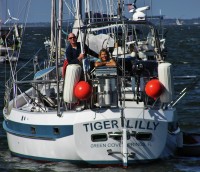
Who: Lilly and Tom Service
Port: Green Cove Springs

